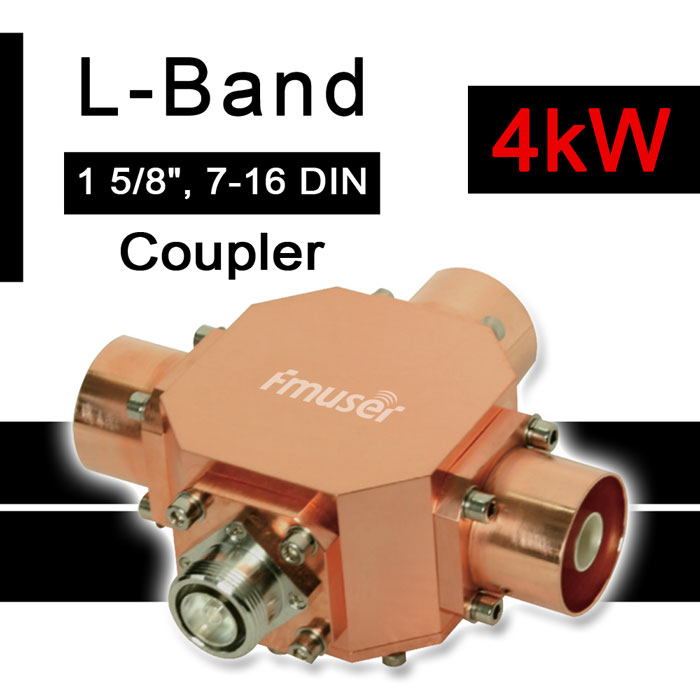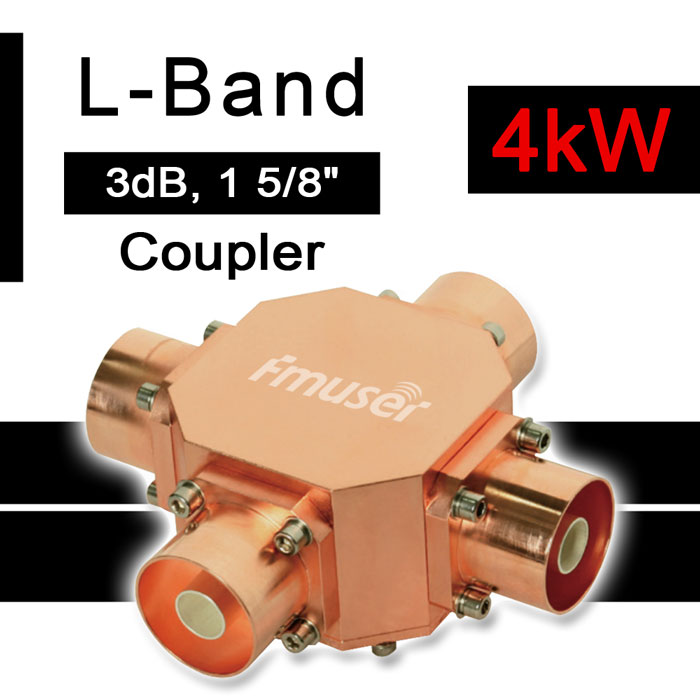
L Band Coupler
L-band couplers are mission-critical components in modern RF systems, enabling seamless signal management across industries like telecommunications, radar, and satellite technology.
1. Engineered to Empower Next-Gen RF Systems with Precision and Reliability
At FMUSER, we specialize in delivering high-performance L-band couplers designed to simplify signal splitting, combining, impedance matching, and isolation for professionals tackling complex RF challenges. This page organizes our solutions by frequency range, power capacity, and application-specific designs, streamlining your selection process for projects ranging from satellite uplinks to radar system upgrades. Trust FMUSER to equip your systems with unmatched precision and scalability.
2. Key Features: Innovation Meets Uncompromising Quality
- Robust Performance: Built for durability with military-grade materials and compliance with ISO certifications.
- Advanced Functionality: Achieve ultra-low insertion loss (<0.3 dB) and high isolation (>30 dB) for flawless signal integrity.
- Scalable Solutions: From compact 5W couplers for small labs to industrial 1000W+ models for satellite arrays.
- Tailored for All Users: Hobbyists benefit from plug-and-play designs, while enterprises leverage custom-engineered systems.
- Future-Proof Technology: Support for emerging standards like 5G backhaul and IoT infrastructure.
3. Diverse Applications: Where FMUSER’s L-Band Couplers Shine
- Satellite Communication Systems: Deploy FMUSER’s couplers to split signals across transponders with unmatched isolation, minimizing interference in high-stakes satellite networks.
- Military Radar Arrays: Ensure real-time signal accuracy in defense radar systems using our ruggedized couplers, tested to withstand extreme temperatures and vibrations.
- Public Safety Broadcast Networks: Deliver reliable signal distribution for emergency communication towers, backed by FMUSER’s fail-safe redundancy and 24/7 durability.
- RF Testing & Monitoring Labs: Leverage our precision couplers for lab-grade signal analysis, featuring ±0.5 dB balance for ultra-accurate measurements.
4. Why Choose FMUSER? Your Partner in RF Excellence
- Cost Efficiency: Factory-direct pricing with no middlemen—savings passed to you.
- Global Stock, Fast Shipping: 80% of orders ship same-day from in-house warehouses.
- Turnkey Solutions: Pre-configured kits with antennas, cables, and couplers for hassle-free deployment.
- Customization & OEM: Modify specs, connectors, or housing to align with your project’s unique needs.
- Proven Expertise: Trusted by clients in aerospace, defense, and telecom for 15+ years.
5. Buying Guide: Match Your Project with the Perfect Coupler
- Assess Technical Needs: Prioritize frequency range (950-2150 MHz typical for L-band) and power handling (5W–2000W).
- Check Compatibility: Ensure connector types (N-type, SMA) and impedance (50Ω/75Ω) match existing infrastructure.
- Budget Alignment: Explore entry-level couplers for prototyping or OEM-grade systems for mass deployment.
- Future Expandability: Opt for modular designs if scaling up in phases.
- What is a L-band coupler, and what is its synonym?
- A L-band coupler is a device that is used to couple or combine multiple signals within a specific frequency range (1 to 2 GHz). It is also known as a low-band coupler.
- How do you use a L-band coupler for broadcasting?
- Steps to correctly use a L-band coupler in a broadcast station:
1. Connect the L-band coupler to the coaxial cable of the broadcast station.
2. Make sure the coupler is properly aligned and that the connectors are properly attached.
3. Ensure that the signal is going through the coupler by performing a signal test.
4. Calibrate the coupler to the correct levels and frequencies.
5. Monitor the signal output to make sure it is not degraded after passing through the coupler.
Problems to avoid when using a L-band coupler in a broadcast station:
1. Avoid connecting and disconnecting the coupler too often, as this may cause damage to the connectors.
2. Make sure the coupler is not overloaded with too much signal, as this can reduce the quality of the signal.
3. Make sure to properly ground the coupler to prevent any interference from other sources.
4. Make sure the coupler is kept away from any sources of heat or moisture.
- How does a L-band coupler work?
- A L-band coupler is a device used in broadcast stations that is used to combine multiple signals into a single signal. It uses a directional coupler to separate the signals, allowing them to be combined into one signal. This is useful for combining signals from different transmitters, allowing for a stronger signal to be broadcast.
- Why is a L-band coupler important for a radio station?
- A L-Band coupler is an important device because it enables a broadcast station to transmit signals and receive them at different frequencies. This is necessary because it allows the station to broadcast multiple channels and to manage interference between different signals. Without the L-Band coupler, it would be difficult for the broadcast station to manage multiple signals in the same frequency range.
- How many types of L-band couplers are there and what are the differences between them?
- There are three types of L-band couplers: Wilkinson, ferrite, and hybrid. The differences between them are primarily in terms of power handling, frequency range, insertion loss, isolation, and return loss. Wilkinson couplers have the highest power handling and frequency range, while ferrite couplers have the lowest insertion loss and highest isolation. Hybrid couplers have the best return loss performance.
- How do you choose the best L-band coupler?
- When choosing the best L-band coupler for a broadcast station, it is important to consider the size, power rating, and frequency range of the coupler. Additionally, you should research the manufacturer to ensure their products are reliable and of high quality. It is also important to consider the connectors used on the coupler and ensure they are compatible with the broadcast station equipment. Finally, be sure to compare prices and read customer reviews to ensure you are getting the most value for your money.
- How do you correctly connect a L-band coupler into the broadcast system?
- 1. Locate the L-band coupler and the antenna input port.
2. Connect the coaxial cable from the antenna input port to the L-band coupler.
3. Attach the L-band coupler to the antenna.
4. Connect the other end of the coaxial cable to a transmitter or receiver.
5. Secure all connections and ensure that the connections are tight.
6. Test the connections to ensure that the system is working properly.
- What equipment is related to a L-band coupler?
- The equipment related to a L-band coupler in a broadcast station typically includes a transmitter, receiver, antenna, coaxial cable, isolator, and power amplifier.
- What are the most important physical and RF specifications of a L-band coupler?
- The most important physical and RF specifications of a L-band coupler include:
-Frequency range: 950-1450 MHz
-Insertion Loss: ≤ 0.25 dB
-Isolation: ≥ 25 dB
-VSWR: ≤ 1.15:1
-Power Handling: ≤ 10W
-Connector Type: N-type Female/Male
- How do you correctly maintain a L-band coupler as an engineer?
- To correctly perform daily maintenance of a L-band coupler in a broadcast station, an engineer should first inspect the coupler for any physical damage, such as loose connections or corrosion. Then, they should check the coupler's power levels and adjust them as necessary. After that, they should inspect the coupler's output signals to make sure they are all within the accepted range. Finally, they should check the coupler's termination impedance and adjust it if necessary.
- How do you repair a L-band coupler if it is not working?
- To repair a L-band coupler, you will need to start by identifying the source of the problem. This could include examining the connections, checking for electrical interference, and testing for a short circuit. Once the cause of the failure has been identified, the necessary parts can be replaced. If the coupler has failed due to a broken part, then the part must be replaced with a new one that is compatible with the system. When replacing the part, it is important to make sure that the part is securely connected and is not damaged in any way. After this is done, the system should be tested to ensure that it is working correctly.
- How do you choose the right packaging for a L-band coupler?
- When choosing packaging for a L-band coupler, it is important to select packaging that is designed to protect the device from external shocks, vibrations, and extreme temperatures. Additionally, it is important to select packaging that is properly sealed to prevent moisture and dust from entering the device. During transportation, it is important to ensure that the box is properly secured and labeled for the type of device inside and that the environment is not too hot or cold.
- What material is used for the casing of a L-band coupler?
- The casing of an L-band coupler is generally made from aluminum or plastic. The material itself does not affect the performance of the coupler, but if the material is not of high quality it can impact the performance.
- What is the basic structure of a L-band coupler?
- The basic structure of a L-band coupler consists of four main components: a transmission line, waveguide, directional coupler and a reflector. The transmission line carries the RF signal and is connected to the input port of the waveguide. The waveguide provides isolation between the transmission line and the directional coupler. The directional coupler is used to split the signal into two parts, one of which is sent to the output port and the other is reflected back to the reflector. The reflector is used to reflect the signal back to the input port so that it can be sent to the output port again.
The transmission line, waveguide and directional coupler all determine the attributes and performance of the L-band coupler. Without any of these structures, the L-band coupler will not be able to function normally.
- Who should be assigned to operate a L-band coupler?
- In a broadcast station, a broadcast engineer should be assigned to manage a L-band coupler. This person should have a working knowledge of broadcast electronics, be able to troubleshoot and repair problems with the coupler, and be able to understand and interpret technical specifications. Additionally, they should have good communication and organizational skills.
CONTACT US


FMUSER INTERNATIONAL GROUP LIMITED.
We are always providing our customers with reliable products and considerate services.
If you would like to keep touch with us directly, please go to contact us





